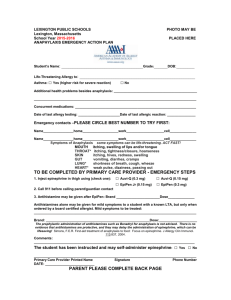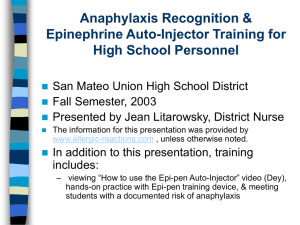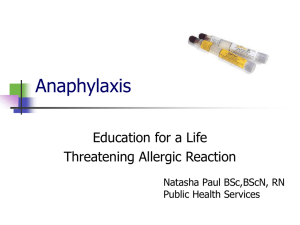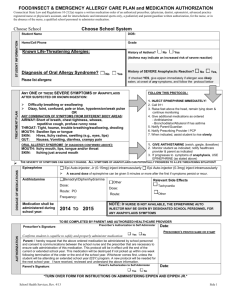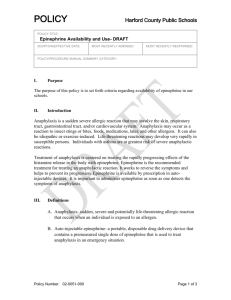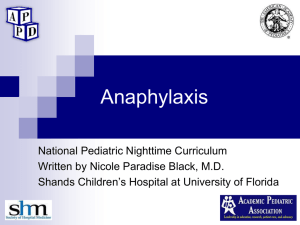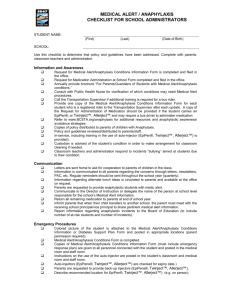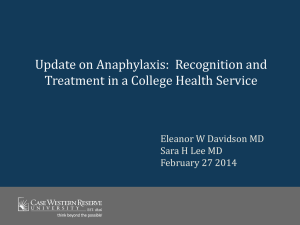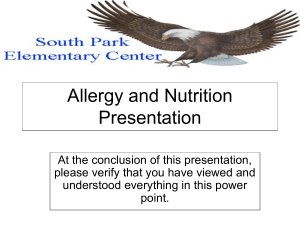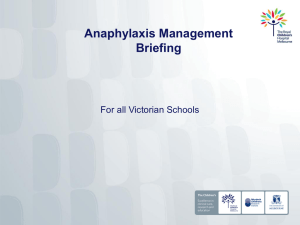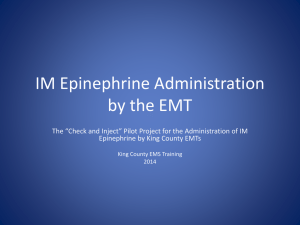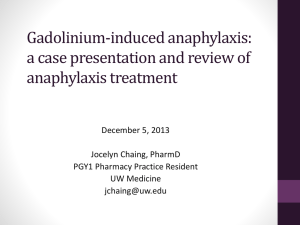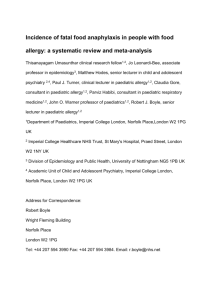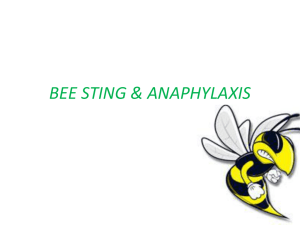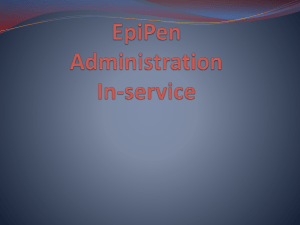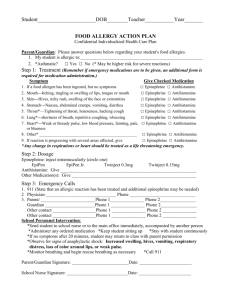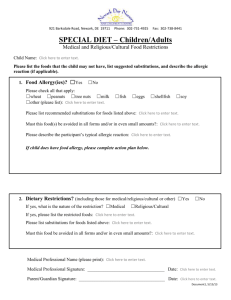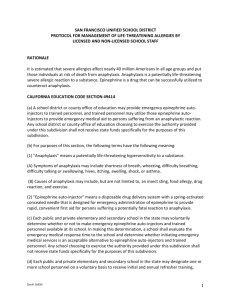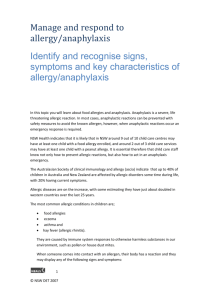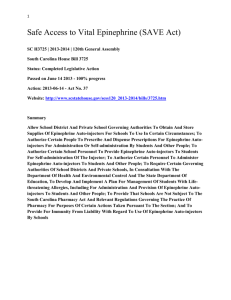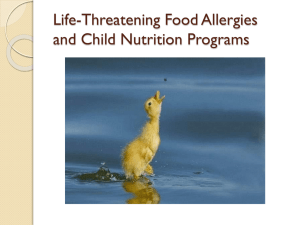Allergy Awareness
advertisement
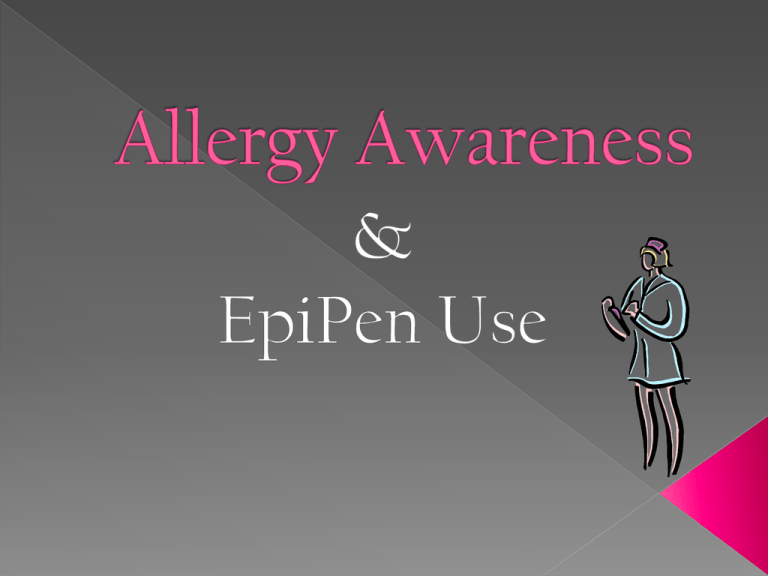
Tree Nuts Soy Milk Shellfish Egg Latex Peanut Fish Bananas Wheat Pollen Animal Dander There are 75 million children in the United States. 6%-8% have food allergies 1.2% have peanut allergies 1.3% have egg allergies 2.5% children have milk allergies Researchers believe that the prevalence of food allergies is increasing and the number of deaths from food allergy-induced anaphylaxis is growing. Children are the largest group of the population affected by food allergies. Peanut allergy is most commonly associated with anaphylaxis. Peanut anaphylaxis accounts for 30,000 Emergency Room visits per year. 150 deaths per year from peanut and tree nut anaphylaxis. An allergy is an abnormal response to a normal substance. This is the body’s attempt to defend itself against substances that are perceived by the body to be harmful (an allergen). There are various degrees of reaction. Symptoms can occur up to 72 hours or more after exposure to the allergen and can last for several days. Symptoms may or may not be life-threatening. Allergic reactions can be caused by certain foods, medications, bee stings and products such as latex. Anaphylaxis is the life-threatening form of an allergic reaction. Anaphylaxis is defined as a sudden, severe allergic response that usually produces breathing difficulties, collapse and possible death. Anaphylaxis usually occurs 1-15 minutes after exposure, rarely after 2 hours. Anaphylaxis requires immediate action-EpiPen administration. Allergic Reactions Runny nose Itchy, red, watery eyes Local reaction to sting, UNLESS known to be allergic to venom Anaphylactic Reactions Hives Swelling (face, lips, tongue, throat, upper airway) Difficulty breathing Cramping, vomiting, diarrhea Difficulty swallowing Weakness, paleness, sweating Feeling of impending doom EpiPens are easy to use. Remember, you must hold the EpiPen in place for 10 seconds. The individual may feel a painful, burning sensation while the medication is being administered. Training is available through the school nurse. You are covered by the Good Samaritan Law. . http://www.epipen.co.uk/patient/howto-use-video.html Be aware of the students that have life-threatening allergies in your classroom and what they are allergic to. TAKE ALL REACTIONS SERIOUSLY ! Administer EpiPen if you recognize a student’s reaction as anaphylactic, or call a trained staff member to immediately assist with the administration of EpiPen. Call 911. Monitor the student’s breathing and circulation, perform CPR when necessary. Notify the parent/guardian. The “Good Samaritan Law” protects all individuals who administer an EpiPen from liability issues. Be familiar with your school’s emergency procedures. Know how to recognize the symptoms of an allergic reaction and what to do if a reaction occurs. Be sure to notify substitute teachers and aides about students’ food allergies. Avoid using food in your lesson plans, such as math lessons and art projects. Don’t use food as an incentive or reward. Minimize the use of food in class parties or celebrations. Develop a plan for communicating with parents about issues that might affect their child’s food allergies. Consider food allergies when planning for field trips, and be sure to include the school nurse and parents early in the planning process. Check the ingredient labels on pet food, if your classroom has a pet. From Food Allergy and Anaphylaxis network To Provide implement policies for the recognition and treatment of anaphylaxis in the school setting. 1. Based on symptoms, determine that an anaphylactic reaction appears to be occurring. Act quickly. It is safer to give epinephrine than to delay treatment. Anaphylaxis is a life-threatening reaction. 2. (If you are alone and are able to provide epinephrine, call out or yell for help as you immediately go to get the epinephrine. Do not take extra time seeking others until you have provided the epinephrine. ) 3. (If you are alone and do not know how to provide epinephrine, call out or yell for help. If someone is available to help you, have them get the personnel trained to provide epinephrine and the epinephrine while you dial 911and follow the dispatcher’s instructions. Advise 911 operator that anaphylaxis is suspected and epinephrine is available. Your goal is to get someone (EMS or trained personnel) to provide epinephrine and care as soon as possible.) 4. Select appropriate epinephrine auto-injector to administer, based on weight. › Dosage: 0.15 mg Epinephrine auto-injector IM, if less than 66 pounds › 0.30 mg Epinephrine auto-injector IM, if 66 pounds or greater › Frequency: If symptoms persist or return, a second dose should be administered 5 to 15 minutes after first dose 5. Inject epinephrine via auto-injector: Pull off safety release cap. Swing and jab firmly into upper, outer thigh, (through clothing if necessary). Hold in place for 10 seconds to deliver medication and then remove. Massage the area for 10 more seconds. Note the time. 6. Call or have a bystander call 911 immediately or activate the Emergency Medical System (EMS). Advise 911 operator that anaphylaxis is suspected and epinephrine was given. 7. Keep the individual either lying down or seated. If they lose consciousness, check if they are breathing and have a pulse. If not, begin CPR (cardiopulmonary resuscitation), call out for help and continue CPR until the individual regains a pulse and is breathing or until EMS arrives and takes over. 8. Call School Nurse/Front Office school personnel and advise of situation. 9. Repeat the dose after 5 to 15 minutes if symptoms persist. 10. Stay with the individual until EMS arrives, continuing to follow the directions in No. 5 above. 11. Provide EMS with Epinephrine auto injector labeled with name, date, and time administered to transport to the ER with the student. 1. Assure parents/guardians have been notified and advised to promptly let the student’s primary care physician know about the episode of suspected anaphylaxis. 2. Complete required documentation of incident. Allergy/Anaphylaxis/Epi Confirmation Survey Epi-Pen, (2012). Available at http://www.epipen.com. Food Allergy and Anaphylaxis Network. (2012). Available at www.foodallergy.org Virginia Department of Education, (2012). Guidelines for Recognition and Treatment of Anaphylaxis in the School Setting. Retrieved July 24, 2012, from http://www.doe.virginia.gov/support/he alth_medical/anaphylaxis_epinephrine
